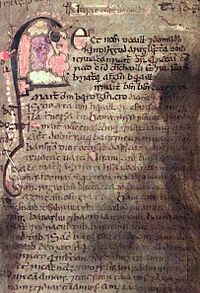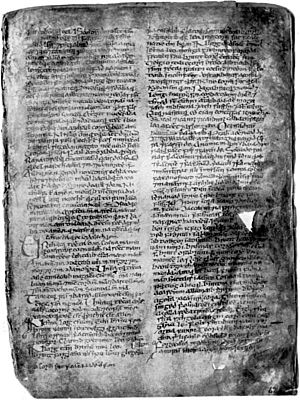Book of Leinster facts for kids
The Book of Leinster (also known as Lebor Laignech in Old Irish) is a very old Irish book from the Middle Ages. It was put together around the year 1160. Today, you can find it in Trinity College Dublin in Ireland.
Some parts of this book, like the Martyrology of Tallaght, are now kept at University College Dublin.
Contents
Who Wrote the Book of Leinster?
The Book of Leinster was not written by just one person. Many different writers worked on it. The main person who put it together was probably Áed Ua Crimthainn. He was an abbot, which is like the head of a monastery, in a place called Tír-Dá-Glas (now Terryglass in County Tipperary).
We know Áed Ua Crimthainn worked on the book because he signed his name in it! He wrote: "Áed Húa Crimthaind wrote this book and collected it from many books." This shows he gathered information from lots of other writings to create this one.
A letter from a bishop named Finn mac Gormáin also calls Áed a very smart person and a chief scholar of Leinster. This means Áed was highly respected for his knowledge.
When Was the Book Written?
Áed and his students worked on the book for a long time, between 1151 and 1224. Most of the work was likely finished in the 1160s.
Since Terryglass monastery burned down in 1164, the book must have been finished somewhere else. Some people think it was completed in places like Stradbally or Clonenagh in County Laois.
Some historians also believe that Diarmait Mac Murchada, who was a king of Leinster, might have asked for this book to be made. He had a strong castle nearby, which connects him to the book's history.
The Book's Journey Through Time
We don't know much about where the Book of Leinster was right after it was finished. But in the 1300s, it was found in a place called Oughaval. It might have been kept in a church building there for many years.
The book got its current name from two scholars, John O'Donovan and Robert Atkinson. They called it the "Book of Leinster" because many of its stories and facts are about the province of Leinster in Ireland.
However, it's now believed that the book was originally known as the Lebor na Nuachongbála. This means "Book of Noghoval," which is the old name for Oughaval in County Laois. This idea was proven by a scholar named R.I. Best. He found old writings from the 1600s that mentioned a "Book of Noghoval" and quoted parts that are exactly from the Book of Leinster.
These old writings were made by Sir James Ware, who stayed with the O'Moore family. This family had connections to the area where the book was made, suggesting they helped him see the manuscript.
What's Inside the Book?
The Book of Leinster has 187 pages, each about 13 inches by 9 inches (33 cm by 23 cm). A note in the book says that about 45 pages have been lost over time.
This book is a huge collection of important old Irish stories, family histories, and myths. It's one of the most valuable sources for learning about medieval Irish literature.
Here are some of the amazing things you can find inside:
- Lebor Gabála Érenn: This is known as the "Book of Invasions." It tells the mythical history of Ireland, describing different groups of people who supposedly came to the island.
- Táin Bó Cuailnge: This is the most complete version of a famous epic tale called "The Cattle Raid of Cooley." It's a thrilling story about warriors and a great cattle raid.
- Metrical Dindshenchas: This is a collection of poems that explain the origins of place names in Ireland. It's like a poetic map of ancient Ireland.
- An Irish version of De excidio Troiae Historia: This is an Irish translation or adaptation of a story about the fall of Troy, showing how Irish scholars were interested in stories from other cultures.
A special edition of the book was published by the Dublin Institute for Advanced Studies. It came out in six volumes over 29 years, making it easier for scholars to study this incredible piece of history.




